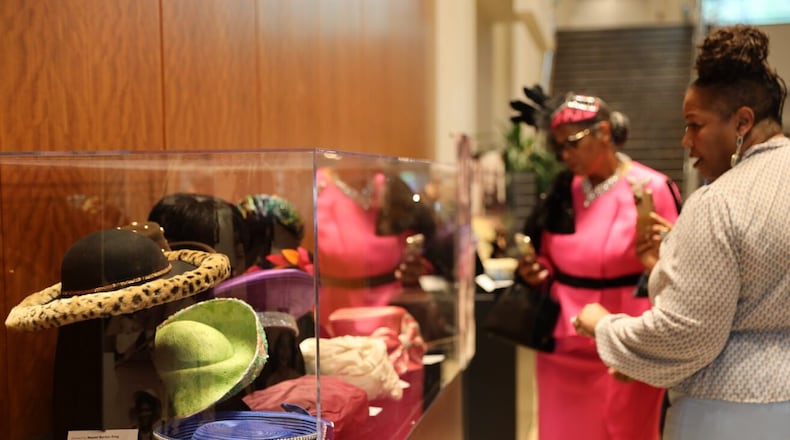During the post-Reconstruction era in 1886, 13 Atlanta residents gathered in Old Fourth Ward to form what we now know as Ebenezer Baptist Church. Over the next decades, the congregation grew as it moved from Airline Street to its final destination on Auburn Avenue.
Members of the congregation have come and gone. But what never changed was the church’s foundation — steadfast Black women, holding their families and the community together. No matter the struggles they may have faced during the week, on Sundays, they showed up dressed in their finest, And, at one time, that meant they all had one thing in common: a church hat.
The practice of women wearing fancy hats has waned. But for one Sunday in July, the fellowship hall at Ebenezer Baptist Church becomes a blur of blue feathers, pink rhinestones and black veils adorning the heads of women during the annual Dr. Christine King Farris Hat & Tea Parade.
Farris, the late sibling of Rev. Martin Luther King Jr., was an avid hat collector. The event isn’t the only time some of the women of Ebenezer don their elaborate headwear, but it is the one day explicitly designed to remember and reclaim a tradition.
“We still wear our hats, particularly on the first Sunday,” said Angela Farris Watkins, the daughter of Christine King Farris. But “more and more, we go to church and we don’t see women wearing hats. I think it is because we haven’t talked enough about that tradition and the real meaning.”
Angela Farris Watkins
Angela Farris Watkins
We live in a moment where it seems that many things in society are changing — or are on the verge of changing — and not all of it feels great. If holding on to something like wearing church hats allows us to maintain a positive connection to culture, then I want to celebrate it.
Church hats may not be making a big comeback in the pews, but they never left the realm of pop culture. The past two decades have brought books, documentaries, museum exhibitions, influencer videos and memes dedicated to the style and spirit of hats that Black women have traditionally worn to church.
Earlier this month, Watkins helped curate an exhibition of hats worn by the women in her family. The Alliance Theatre and the King Center sponsored the exhibition, which was on display during the recent production of “The Preacher’s Wife.” About 20 hats worn by Alberta Williams King (MLK Jr.’s mother), Coretta Scott King (MLK Jr.’s wife) and Naomi Barber King (MLK Jr.’s sister-in-law) — all of them preacher’s wives — were on view, alongside hats worn by Watkins’ mom, who was not a preacher’s wife but was known as the grande dame of fashion.
The King women wore hats every Sunday as a testament to both their faith and their freedom, said Watkins, who spoke to the crowd at the opening reception. “We talked about the value of Black women wearing hats and the notion that we were going to look the part of free Black women while we were working on getting free.”
Adorned with bows, fur and pearls, with wide brims, small brims and no brims, the hats encased in glass displays represented art and history.
Enslaved women toiled in the fields and used head coverings as protection. On Sunday, their only day of rest, they would dress up their plain hats with flowers or fold their headscarves into elaborate headpieces and go to church, the one place they were allowed to clean up nicely.
James Allen McCune
James Allen McCune
This tradition endured through generations of Black women (and men) as a way to show reverence to God, but also to show off one’s style and sense of self-worth. A hat was part of the uniform for Black women during the civil rights movement. It made a statement without the wearer saying a word.
But, by the 1960s, the decline in hat-wearing at church had begun among the members of younger generations, who found it hard to properly perch a cloche or broad-brimmed bonnet on top of an afro or fluffed-up bouffant.
My mother had a few hat boxes in her closet, but mostly I remember the fur hat she would wear during the coldest Midwestern mornings when we would head to church. I always thought she wore it to keep her head warm, but I would come to understand that this hat was about more than practicality. It was protection from the cold, but it was also a connection to the past and a statement of her status in the present.
In generations since, not many of us have kept elaborate headwear in our closets. My friends frantically search for fascinators to wear to Kentucky Derby parties or pill box hats for Easter Sunday.
Watkins said she wore hats only occasionally when she was younger. But, after her mother died, it became important to her to carry on a Sunday tradition. She stepped up her own collection and, on the day we spoke, she was meeting with her milliner to discuss hat options for the upcoming parade and a few other events.
On July 14, the women of Ebenezer will once again put their hats on display. For at least one afternoon, they will preserve this custom. And, in doing so, they honor all the mothers, grandmothers and great-grandmothers who walked before them — heads, hats and hopes held high.
Read more on the Real Life blog (www.ajc.com/opinion/real-life-blog/) and find Nedra on Facebook (www.facebook.com/AJCRealLifeColumn) and Twitter (@nrhoneajc) or email her at nedra.rhone@ajc.com.
About the Author








